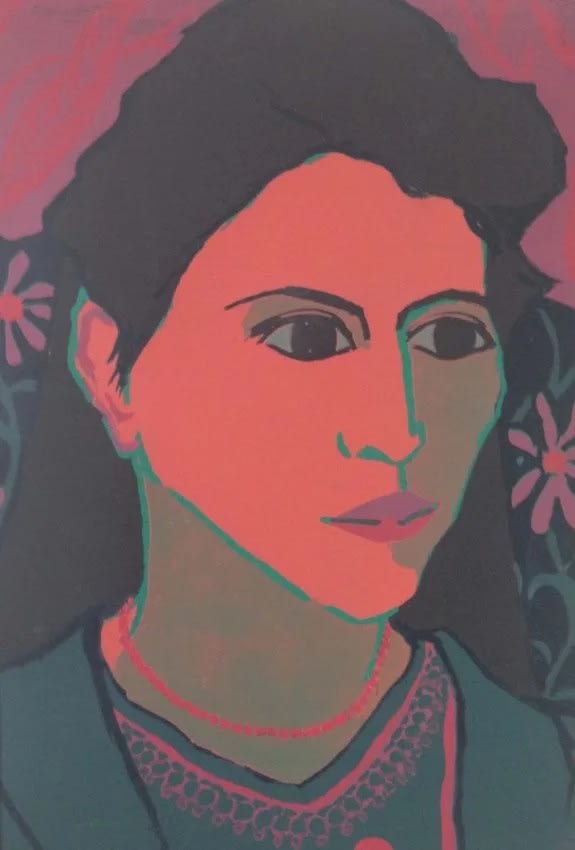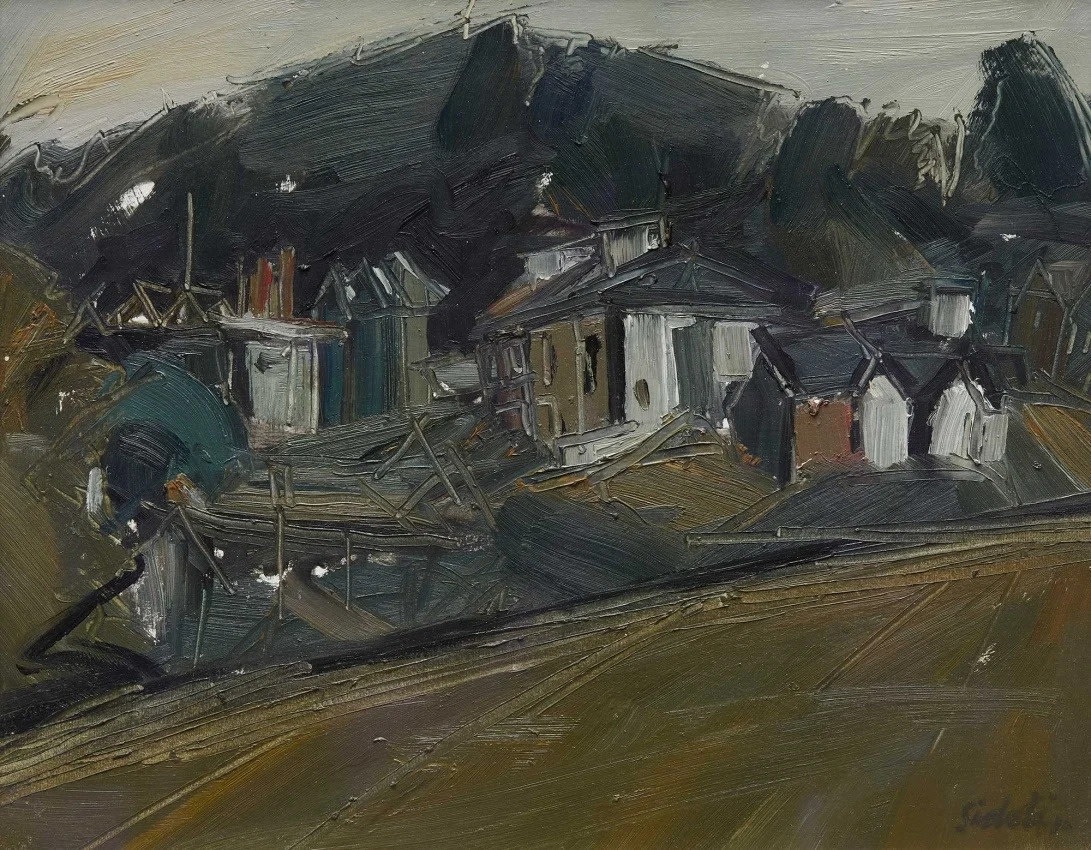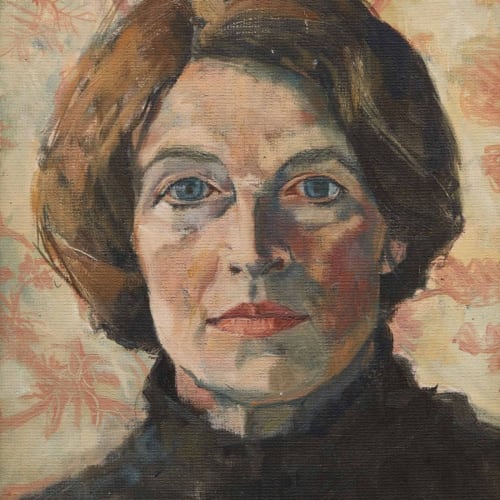Following the sad news that Dawn Sidoli NEAC RWA passed away in May 2022, we were reminded by David Parfitt NEAC of an interview that he conducted with Dawn back in 2004. We are delighted to share it with you here by way of a tribute. It's a fascinating insight into Dawn's life and work, with her wit and wisdom shining through . . .
Dawn Sidoli (DS): I went to Northampton School of Art straight from a strict convent – I won’t tell you the date. I was let loose because I wasn’t very good at anything else. One of the Sisters, Mary Rose, said, “I think she’d better go to art school.”
I started at fifteen, on a two-year Intermediate course, and had a whale of a time. We were involved in rags, we went to the pictures and used to scoot off to the races, the local steeplechases, things like that. So I failed the exams and I thought, “What am I to do?”
I did a year’s commercial art and then joined a large department store in Northampton. After a short course learning brush lettering, I helped with window dressing or in the basement, writing notices for twinsets and things like that. I felt fed up and at a dead end. Then, through a friend who is brilliant with children and a born teacher, I went on to Teacher Training College in Manchester.
It was a very hard two-year course. We resolved – the three of us in lodgings together – that every Saturday, we’d down tools and go out on the town. One evening, I went dancing and met my future husband. After I had done two years teaching, we got married and moved to Newark. I had put painting to the back of my mind, what with teaching and family. However, Newark did have a very good Art Club. If I could get the children to bed by 7pm, I went there; it put me on course again.
One memory stays with me. There’s a famous castle at Newark, where King John is supposed to have died of a surfeit of lampreys. I did a small painting of that. There was a crit. coming up so I popped the picture in a little old frame and took it along. I’ve never forgotten, he gave me such a telling off I went PINK. Because he said, “A nice painting, but what on earth is the point of doing a painting like this if you’re going to put it in a frame like that”. And I hadn’t even thought about it.
'Are You Sure?' (oil, 36 x 38 cm)
David Parfitt (DP): When did you become a full-time painter?
DS: When we moved to Bristol and the children were all at school. I looked up Art Societies in the telephone directory and there was one called the Bristol Savages. That sounded good so I rang them and said, “Excuse me, I wonder if I can join the Savages?” And the answer was, “Oh, no, no, no, we don’t have any lady members”!
I joined Clifton Arts Club in 1973 and am now one of their Vice Presidents. They have been brilliant, such lovely people. They meet every week for a talk or a crit., and on Saturdays have a painting day. All that helped me enormously because I met many like-minded people. So I started thinking, “This is wonderful, time to myself and I’m doing what I want to do.”
I joined the Poly – the building attached to the Royal West of England Academy that ran Adult Education Art Classes. They have a large life room, and I just walked in and felt completely at home. I did some teaching too, one or two evening classes, and could have done a lot more.
Decision time: I had a family and a home to run, and a dog to walk – did I want to teach or paint? The answer was clear. I went to London to see exhibitions of painters like Auerbach and Munch, and to Paris with the Clifton group. We painted in Yugoslavia too, and a painting from that trip was my first to be accepted by the RA (1977). Suddenly my life took off. I was able to walk down to the Poly to paint, and later to study printmaking which helped with my painting – you can see, making prints, how everything has to be simplified.
'The Chilean Girl' (oil screenprint, 56 cm x 46 cm)
DP: Would you call Auerbach an influence?
DS: Yes. Auerbach, Joseph Herman, Joan Eardley – more abstract. Daumier, and Sheila Fell too, I love her work. At that time, I used a traditional palette: raw umber, cobalt, ochre, white, burnt sienna, alizarin, and terre verte. I found a book on Lowry – why do I like Lowry so much? I realized it was because there was no green in his paintings. It was all shapes and beautiful reds, pinks, blues, blacks, off-whites. I’ve used his palette ever since. Lamp black, white, yellow ochre, vermilion and prussian blue, with sometimes a touch of cerulean, alizarin or cadmium yellow.
DP: Do you paint mostly on the spot?
DS: Yes, I do. I go in my Mini Cooper, park and paint out of the window. I drive down to the front here at Portishead, when it’s all moody, or up along the Nore Road where you can look down on Battery Point. I paint on primed card propped on a large board, sitting in the passenger seat with the paints on the driver’s seat. I wear an old apron and have everything to hand – my “Mini studio” – I’ve got quite expert at it! You feel quite bent double when you get out of the car.
'Portishead From the Nore' (oil, 46 x 56 cm)
I don’t like to paint on beautiful days like this – it makes me shudder and think of chocolate boxes. I used to go out with the Clifton Arts Club on Saturdays and sometimes we went to beautiful country houses, roses round the door, ducks on the pond, and I’d come back with my work and think – ugh!
I use house painting brushes now to avoid working in a fiddly, illustrative style. As a medium I use oleopasto, it really gives texture. The best paintings come off when I’m tired and I’ve been painting for a long while. Then suddenly it comes better. It’s strange – why do I have to go through all this agony to get to the more abstract view?
Back in the studio, I keep them for a while – turned to the wall. When I look at them again, I find it helps to put a mount round them, and sometimes I crop them. My frames are made and primed white by Joe in Bristol, and then I have the blood, sweat and tears of colour-washing them myself. All painters in Bristol know Joe. If you’re feeling lonely or have been in the studio too long you think, “Oh I’ll just go to Joe’s and see who’s around.”
DP: Tell me more about subject matter.
DS: I used to paint urban scenes, and still enjoy painting portraits. But now I concentrate on coastal scenes as our house overlooks the Bristol Channel. The mood is ever-changing and the place unspoilt. And I love painting the Burren in the west of Ireland, it speaks to me in a similar way. I like to paint out-of-doors, but being a woman I feel uncomfortable standing painting on my own; that’s why I use my Mini round here. However, I saw an advert for a painting centre in County Clare. I went there in August, for the second time, and I hope to go there again. I so enjoyed it – painting with a group, totally relaxed and nothing to worry about.
VIEW DAWN SIDOLI'S PROFILE PAGE TO FIND OUT MORE
"I admired and collected Dawn’s paintings. The simple arrangements of her still life that never looked contrived and her landscapes - dark but painted with passion and luscious paint! She will be sadly missed" Jane Corsellis

